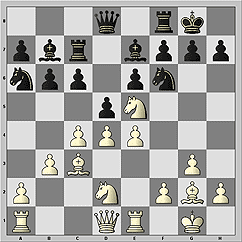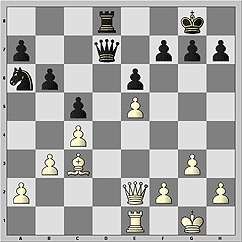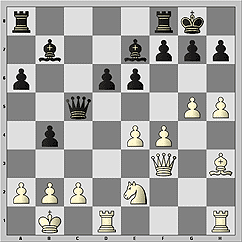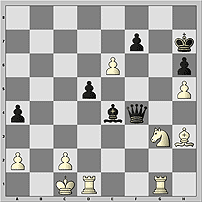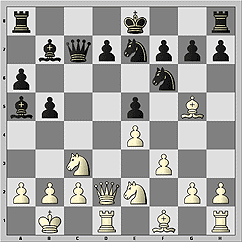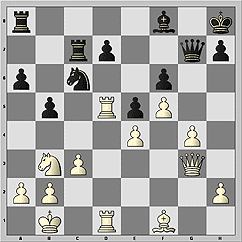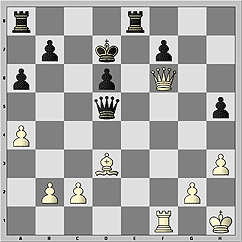 | Последние турниры |
Чемпионат России
СуперФинал

02.12.2006
Суперфинал чемпионата России проходит в Москве, в ЦДШ им. М.М.Ботвинника со 2 по 15 декабря при 12 участниках по круговой системе.
Крамник - Fritz

25.11.2006
С 25 ноября по 5 декабря в Бонне чемпион мира Владимир Крамник сыграет матч из 6 партий с программой Deep Fritz. В случае победы Крамник получит 1 миллион долларов, тем самым удвоив свой стартовый гонорар ($500000).
Мемориал Таля

5.11.2006
В Москве с 5 по 19 ноября проходил Мемориал Таля, в программе которого супертурнир 20-й категории и выдающийся по составу блицтурнир. Призовой фонд каждого состязания - 100.000 долларов.
Топалов - Крамник

23.09.2006
После того как "основное время" не выявило победителя (счет 6:6), 13 октября соперники сыграли 4 дополнительных поединка с укороченным контролем времени.
Томск. Высшая лига

2.09.2006
Со 2 по 11 сентября Томск принимает Высшую лигу чемпионата России 2006 года. В турнире участвуют 58 шахматистов - как получившие персональные приглашения, так и победившие в отборочных состязаниях.
Майнц

17.08.2006
В последние годы фестиваль в Майнце вслед за "Амбер-турниром" стал центром легких шахматных жанров. Наряду с массовыми ристалищами традиционно проходят чемпионские дуэли.
Россия - Китай

10.08.2006
С 10 по 20 августа в Китае проходит товарищеский матч сборных России и Китая. В нынешнем поединке как мужчины, так и женщины соревнуются на пяти досках по шевенингенской системе в два круга.
Все материалы
ChessPro

|
|

|
|
 |
By grandmaster
Sergey SHIPOV |
Infinite harmony of the world |
As physicist and materialist I am glad that it has finally happened. The train slowed down! The energy conservation rule works, perpetum mobile does not exists, the harmony is resorted. It is absolutely unbelievable that a human can play eight full-scale games against elite players on the highest possible level and win them all!
On the other, hand it is very hard to measure the reserves of human organism. Formerly it was a common belief that jumpers would never surmount the 240-cm barrier, but it actually happened. It is funny to recall the time when 10-second mark was regarded unbreakable for 100-meter sprinters. As for chess, it is very difficult to draw the line between possible and absolutely unreal. Great players keep raising the bar higher and higher. Topalov has all the rights to be included in this list, especially if he retains his leading position.
Currently is looks like the intrigue of the event is dead. The pursuers have not shined; the finish is nearing. Such a tight schedule suggests that sooner or later the recession is inevitable. Therefore, some mistake and lack of aggression are explainable and forgettable. All these factors play in Topalov’s hands.
Queen’s Indian Defense E15
Veselin TOPALOV (BUL) – Peter LEKO (HUN)
1.d4 (Probably, Veselin decided not to reveal his novelties in the Sveshnikov system of the Sicilian Defense; if he has them…) 1...Nf6 2.c4 e6 3.Nf3 b6 4.g3 Ba6 5.b3 Bb4+ 6.Bd2 Be7 7.Bg2 c6 8.Bc3 d5 9.Ne5 0–0 10.0–0.
10...Bb7! The exclamation mark does not imply that this move is the best in this position. The official theory prefers 10...Nfd7. However, Peter’s choice is very good from the practical standpoint. Veselin introduced new strong move and nearly beat Anand in 10…Nfd7 line. Black’s strategy with the development of the knight to a6 came as an unpleasant surprise to the Bulgarian. His long reflextion on every move suggest that his preparation in this line was not deep enough.
11.Nd2 Na6! (Karpov proved on many occasions that the knight position on a6 is very promising) 12.e4 Rc8. Immediate opening the center is also possible: 12...c5 13.exd5 exd5 14.Re1 cxd4 15.Bxd4 Nc5 16.Ng4 dxc4 17.Nxc4 Bxg2 18.Kxg2 Nxg4 19.Qxg4 Bf6 20.Rad1 h5! 21.Bxf6 hxg4 22.Bxd8 Raxd8 and Black equalized (Kamsky – Karpov, Elista 1996).
13.Re1. It is interesting to note that the white knight spectacularly placed on e5 hampers White’s pieces. For example the e4 pawn can’t advance to e5; the e1-rook can’t x-ray the black bishop on e7.
13...Rc7! Excelelnt maneuver. Black is going to transfer his queen to a8, the rook to d8 and to open the center with c6-c5.
14.Nd3. Here comes a novelty. Black had no problems in the primary source game: 14.a3 c5 (White was threatening to put a clamp on the queenside with b3-b4) 15.dxc5 Nxc5 16.exd5 exd5 17.b4 Ne6 18.Bb2 dxc4 19.Bxb7 c3 20.Bxc3 Rxc3 21.Bg2 b5! – Whit’s initiative petered out (Chernin – Georgiev, Spain 1997).
14...dxe4! 15.Nxe4 c5. This breakthrough in the center brings about an equal position.
16.Nxf6+. Veselin keeps creating over the board rather by inertia. However, he did not go too far! In the line 16.dxc5 Nxe4 17.Bxe4 Bxe4 18.Rxe4 Black should not engage into complications with 18...Rd7 19.Qg4 Bg5 20.Ne5 f5 21.Qh5 fxe4 (21...g6 22.Nxg6!) 22.Nxd7 Qxd7 23.Qxg5 Nxc5 as his active pieces hardly offset the flaws of the pawn structure. Simpler and better is 18...Nxc5 with an equal position; In the starting rounds Topalov could have opted for an unclear 16.d5 exd5 17.Nxf6+ Bxf6 18.Bxf6 Qxf6 19.cxd5 where the d5 may be either White’s trump or weakness. However, there is no need for the leader to overcommitt in first round of the second part of the event.
16...Bxf6 17.Bxb7 Rxb7 18.Ne5 Bxe5. The option 18...cxd4 19.Bxd4 is risky from the strategic standpoint. As the e5-knight is impossible to bear, Black has to trade it. In this case the white bishop is more powerful in the game on two wings.
19.dxe5 Rd7 20.Qe2 Qc7 (Leko skillfully develops his pieces. In some lines the a6-knight may jump to b4) 21.Rad1 Rfd8 22.Rxd7 Qxd7. Although Black controls the only open file it does not promise no tangible advantage.
23.Qe4 (now white is prepared to carry out the maneuver Re1-e2-d2) 23...Nb8. After 23...Qd3 24.Qxd3 (24.Qh4!?) 24...Rxd3 White can place his rook to с1 and transfer the king to e2. Even simpler is 25.Re3 Rxe3 26.fxe3 – neither party can lose this endgame. Black could have tried to play for win with 23...Nb4!? as the exchange of minor pieces favors Black.
24.Kg2. Draw.
Peter did his best. Well, almost! He opted a sharp risky variation, outplayed his opponent with many subtle moves, but… run out of steam to convert it into the victory.
Sicilian Defense B80
Michael ADAMS (ENG) – Peter SVIDLER (RUS)
1.e4 c5 2.Nf3 e6 3.d4 cxd4 4.Nxd4 Nc6 5.Nc3 d6 6.Be3 Nf6 7.Qd2! Let’s give the English GM full credit. After several painful defeats he did not lose confidence. Michael keep playing in aggressive style. Usually Adams castle short in the Sicilian Defense but this time he ventured upon the sharpest plan with castling long.
7...Be7 8.f3 0–0 9.0–0–0 a6 10.g4 (a well-known theoretical position of the English attack emerged on the board) 10...Nxd4 11.Qxd4 Nd7 12.h4 b5 13.g5 Qa5 14.Kb1 b4 15.Ne2 Bb7. Black also tested the lunge 15...Nc5 followed by e6-e5, clearing the e6 for his light-squared bishop.
16.h5! White takes forestalling approach which in the spirit of the opening. It is very important to launch an attack as soon as possible!
16...Ne5. This novelty is on the verge of utmost jeopardy. Black provokes White – go ahead, attack, deliver checkmate… Previously Black took the g5-pawn and undeservedly survived: 16...Bxg5 17.Bxg5 Qxg5 18.h6 Rfd8 (совсем не смотрится 18...e5 19.Qxb4 Nc5 20.Rxd6 Qe3 21.Qc3 Qxc3 22.Nxc3 Vasiesiu - Navrotescu, Romania, 2001) 19.hxg7 Qf6 20.Qe3 Ne5 21.Nd4 Ng6 22.Bd3 Qf4 23.Qf2 d5 24.e5 Qxe5 25.Rdg1 Qxg7 26.f4 – it is hard to believe that Black can withstand this attack, but it is exactly what happened in the game De la Villa Garcia – Bauer (Lausanne 2001).
17.f4. We can only guess what did Peter prepared for a natural 17.h6! In this case the attack on g7 pins down the e5-knight. The knight can’t capture on f3, whereas White threatens with f3-f4 winning this piece. Whatever his idea might be 17...Qc5, 17...Rfc8 or something else it will remain a mystery for a while.
17...Ng4. During the game I was under impression that Black had to play 17...Nf3 18.Qd3 d5, but when I started analyzing his position quickly lost its luster: 19.Bg2! Rad8! (19...dxe4? 20.Qd7 Bd5 21.Rxd5!) 20.e5 d4 21.Nxd4 Nxe5 (21...Nxd4 22.Bxb7) 22.Qe2 Bxg2 23.Qxg2 Nc4 24.Bc1 – White is threatening not only with g5-g6 but also with his knight’s infiltration to c6.
18.Bh3 (here 18.h6 fails to 18…e5! 19.Qd3 g6 and Black is better; as an old proverb reads “every fuite has its own season”) 18...Nxe3 19.Qxe3 Qc5! 20.Qd3. White can’t win a piece with 20.Qxc5 dxc5 21.Rd7 in view of 21...Bxe4!
20...Qb5 21.Qe3 Qc5! (I think Black checked the opponent’s intentions...) 22.Qf3! Which turned out to be very serious. After 22.Qd3 Black can avoid repetition and continue his risky pushing for a win. How? It is a tough question. White threatens with g5-g6, Black does not have many options. I can suggest a desperado 22...Kh8 23.g6 f5!?, but let me refrain from analyzing this line.
Have a look at this position. I give you five shots to guess the move made by Svidler.
22...h6!? That is one of the most impressive moves of the eight round the whole tournament. Black is opening the position to secure his king!
23.gxh6 gxh6 24.f5 Qe5! As Black’s dark-squared bishop has no opponent, Peter set up flexible defense keeping counterattacking ideas on the back of his mind. Note that the checkmate on b2 is just two moves away.
25.Rhg1+.
25...Kh7. Another unexpected decision. The move 25...Kh8 suggested itself as the attempt of direct attack 26.Qe3 Bg5 27.Rxg5 hxg5 28.Qxg5 is met with an icy 28...Kh7!!
26.fxe6 Bxe4 27.Qb3 a5. This excellent idea was not materialized. However, I think even better was 27...Rac8 28.Nd4 (28.Rd2 f5!) 28...d5 29.Rge1 (29.exf7 Rc4!) 29...f5 – Black build solid fortifications and gets an upper hand.
28.Bg2. Heavenly variations arise after 28.Ng3! a4! (in case of 28...f5 29.Nxe4 fxe4 30.Rd5 Qf4 31.Bg2 Black can’t hold the e4-pawn) 29.Qxb4 d5! (this piece sacrifice is the only Black’s chance) 30.Qxe7 Rab8 31.Qa3 Rxb2+ 32.Qxb2 Rb8 33.Qxb8 Qxb8+ 34.Kc1 Qf4+
This line is force. Here trying to avoid one perpetual White falls into another one – 35.Rd2 Qf6 36.Kd1 Qa1+ 37.Ke2 Qxg1 38.e7 Qxg3 39.e8Q Qf3+ 40.Ke1 Qe3+ 41.Re2 Qc3+ 42.Kd1 Qa1+ 43.Kd2 Qd4+ 44.Ke1 Qc3+ 45.Kf2 Qf3+ 46.Kg1 Qh1+ 47.Kf2 Qf3+ 48.Ke1 Qc3+ and Black being the rook down gets off the hook. Such a draw would deserve the brilliancy prize.
28...Bxg2 29.Rxg2 fxe6 (Black won a pawn, but with the queens on the board safety of the kings is much more important; Black has nothing to brag about here) 30.Qd3+ Qf5 31.Nd4?! Adams took a surprising decision. He preferred an inferior endgame to a sharp middle game! After 31.Qd4 Qe5 32.Qd3+ Qf5 33.Qd4 Black had to find the continuation 33...e5! (33...Rf7 34.Qc4!) 34.Qg1 Bg5, which gave them advantage.
31...Qxd3 32.cxd3. Why did not Peter play simply 32...e5! – I don’t know, ask me an easier question. Probably he got sick of defense and wanted to attack at any cost. I think Black had good winning chances with an extra pawn.
32...Rg8 33.Rxg8 Rxg8 34.Nxe6 Rg2 35.Rf1 Kg8. The rest is the time scramble. All sarcastic annotators are better to shut up. I just suggest them recalling themselves in the time trouble…
36.a4?! (36.b3! Rh2 37.Rf5!=) 36...b3 (36...Rh2! 37.Rf5 b3–/+) 37.Nd4! Bf6 38.Nxb3 Rxb2+ 39.Kc1 Rxb3 (39...Bc3 40.Nxa5!) 40.Rxf6 Rxd3.
Draw.
The chess queen offered too generous odds to his opponent in the opening. Later on she fought like a lioness, but failed escape.
Sicilian Defense B48
Vishwanatan ANAND (IND) – Judit POLGAR (HUN)
1.e4 c5 2.Nf3 e6 3.d4 cxd4 4.Nxd4 Nc6 5.Nc3 Qc7 6.Be3 a6 7.Qd2 Nf6 8.0–0–0 Bb4 9.f3 Ne7 10.Nde2 b5. Even after painful defeat in the game against Leko Polgar still believes in this line. She is probably wrong.
11.Bf4. This rare move wasn’t regarded dangerous for black. Other possible continuations are 11.Qe1 and 11.Kb1. Leko – Polgar game saw 11.g4.
11...e5 12.Bg5 Bb7 13.Kb1 Ba5.
14.Bxf6! Novelty which can be easily found in the home analysis. This move just suggests itself! White disrupts Black’s pawn structure and sends his queen to the king side to launch an attack. The game Akopian – Nisipeanu (Gothenburg 2005) ended in a bit strange draw after 14.Qd6 Nfd5 15.Qxc7 Nxc7 16.Ng3 f6. It was a team tournament, probably there were some special circumstances...
14...gxf6 15.Qh6 Qb6 16.g3! White bishop is going to appears on h3 with a strong effect. It’s hard to understand what did attract Polgar in such a dubious position in home preparation. In the course of the game she of course did realize that her cheese is hard.
16...Qe6. After 16...b4!? White can avoid the knight exchange on d5: 17.Na4 Qc6 18.b3 0–0–0 (18...d5 19.Bh3) 19.Qh5, retaining serious advantage. 16...f5 didn’t work in view of 17.Qg7 Rg8 18.Qxe5 Qe6 19.Qf4!
17.Bh3 f5 (resourcefully played, but still insufficient for equalizing) 18.Qh4! f6 (after 18...d5 19.Bxf5 Nxf5 20.exf5 Black can’t hold the d5 square) 19.exf5 Qf7 20.Ne4 Bxe4 21.fxe4.
Black is hopeless. Judit is down a pawn and under attack. Unlike Anand, she was already in time scramble also. That’s why it was even more surprising too see how the position got more and more complicated, and it was a moment when it seemed that there would be no win for White...
21...Nc6 22.Rd6 0–0 23.Rhd1 Ra7 24.Bf1 Rc7 25.Nc1 (let me not to go into details commenting this part of the game) 25...Bb4 26.R6d5 Rfc8 27.Nb3 Bf8 28.c3 Kh8 29.g4 Qg7 30.Qg3 Ra8.
One of the moments, when Vishy didn’t choose the best option: 31.a3. Direct attack leads to a simple win – 31.h4! h6 32.Qf3, for example: 32...b4 33.g5! bxc3 34.Qxc3 hxg5 35.hxg5 fxg5 36.Bc4!, and black king is dead.
31...Rac8 32.Nc1 Na5 33.Na2 Nb3 34.h4 Nc5 35.Bd3 Na4 36.Bc2 Nb6 37.R5d3.
37...d5! (a powerful blow; Black sacrifices another pawn, achieving an ideal setup of her pieces) 38.exd5 Bd6 39.Bb3 a5 40.Qf2 Nc4. Here I thought that Anand would have another setback. However, he managed to brace himself up and finished the game worthily.
41.Qe2 Rg8 42.Rg1 Qh6 43.Rdd1 a4 (43...Qxh4!? was worth trying) 44.Bxc4 Rxc4.
45.g5! fxg5 (45...Qxh4 46.g6!) 46.hxg5 Rxg5 47.Qe3 Rf4 48.Qb6 (White manages to clear the queen side from the black pawns) 48...Rgxf5 49.Qxb5 Rf8 50.Nb4 e4 51.Rde1 Rh4 52.Ka1 e3 53.Qxa4 Re4 54.Qa6 Rfe8 55.Re2 Qf8 56.Qd3 Qf6 57.Nc2 Bc5 58.Rge1 Qe5.
59.b4! Bb6 60.Kb2 h5 61.d6 Qf5 62.Rxe3! White pawn goes to d7, disrupting the coordination of black pieces. Black resigns.
In the following game in his quest for the victory Black allowed White to start a menacing attack! Black’s plan proved right: in the time-trouble White let the advantage slip away and then missed a draw.
Sicilian Defense B83
Rustam KASIMDZHANOV (UZB) – Alexander MOROZEVICH (RUS)
1.e4 c5 2.Nf3 e6 3.d4 cxd4 4.Nxd4 Nc6 5.Nc3 d6 6.Be2 Nf6 7.Be3 Be7 8.0–0 0–0 9.Kh1 Nxd4 10.Bxd4 e5 11.Be3 Be6 12.f4 exf4 13.Rxf4.
13...a6. As usual Morozevich conducts the middle game in his trademarked original style. His plan with a black-squared bishops exchange is absolutely new. He has a knack for inventing something new in old, half-forgotten lines! It’s a rare talent… It’s well-known that in this type of positions Black should try to bring his black-squared bishop into play through f6. For example, there is a standard way - 13...Ne8! – the bishop goes to e5, and then a knight returns from e8 – 14.Bd4 Bg5 15.Rf1 Bf6 16.Bxf6 Nxf6, and Black has sufficient counterplay (Onischuk – Leko, Tilburg 1997).
14.a4 Qa5 15.Qd2 Rfc8 16.Rd1.
16...Bd8! (well-done! – bishop goes to b6) 17.Rff1 Bb6 18.Bd4 Bxd4 19.Qxd4 Rc6 (Black succeeded in trading the bishops, but Morozevich’s heavy pieces are too far away from the king) 20.Nd5! Another move order was also possible – 20.Rxf6 gxf6 21.Nd5 Bxd5 22.exd5.
20...Bxd5 21.exd5 Rcc8. Of course, it’s pretty hard to dare sacrifice a tempo for a one poor pawn: 21...Rxc2!? 22.Bd3 Rcc8 23.Rxf6 gxf6, and White has several promising continuations. I didn’t find a clear win here, but Black hangs by a thread...
22.Rxf6! (there is no time for reflections) 22...gxf6 23.Bd3 Re8! (the only defense; the threat of checkmate on the first rank keeps White back) 24.Qh4. After 24.b4 Qc7 25.Rf1 Qe7 26.Rxf6 the black queen is already in the thick of things. That’s why Black can escape – 26...Qe1+ 27.Rf1 Re7! etc.
24...Kf8.
25.Rf1! After 25.Bxh7 White has a strong passer. This move deserved attention and was even probably winning, but it’s not human-like! Any grandmaster rejects such a move during the game without hesitations – there is no piece coordination, no guidelines.
25...Qxd5 (and here comes Kasimdzhanov’s time trouble) 26.Qh6+. There is no point in pushing out the black king when his only dream is to run away like a hare. 26.Qxf6 Qe6 27.Qh8+ Ke7 28.Qd4! was definitely stronger – in several lines White wins a pawn (f7 or h7) and keeps pushing for a win without any risk.
26...Ke7 27.Qxf6+ Kd7 28.h3 h5. Have a look! White just can’t lose here! Even after exchange on f7 White runs no risk having a strong bishop on d3 and no pawn weaknesses. 29.b3 was a perfect starter.
29.b4 (White is carried away with attacking ideas) 29...Re3 30.Rf5 Re5 31.Rxe5. Up to downstairs! I prefer 31.Qxf7+ Qxf7 32.Rxf7+, though after inaccurate b2-b4 White already has some problems on the queen side.
31...dxe5 32.Qf5+? A serious mistake. After 32.Bf5+ Kc7 White has a nice trick 33.c4!, and Black loses one of its central pawns. But Black has the upper hand anyway. He will keep the e5 pawn, that can become a real power.
32...Qe6 33.Qxh5 e4! (the passer is advancing; at the same time Black cuts down the white bishop, who has no good berthing) 34.Be2 Rf8 35.b5 f5! It’s all over now. Black has a clear plan of advancing his central pawns.
36.bxa6 bxa6 37.Qh7+ (White’s active queen is harmless; it buzzes, but can’t bite) 37...Qf7 38.Qh6 Qf6 39.Qh7+ Rf7 40.Qg8 Ke7 41.Bc4 Rf8 42.Qh7+ Kd6 43.Qb7 Qa1+ 44.Kh2 Qe5+ 45.Kh1 a5 46.Qb6+ Ke7 47.Qb7+ Kf6 48.Qb6+ Kg7 49.Qb7+ Kh6 50.Qb6+ Rf6 51.Qd8 Rd6 52.Qf8+ Kg5 53.Be2.
53...Kf4! Black king heads his attacking forces. He goes to f2 to complete weaving the checkmate net. White resigns.
Standing after the eighth round: 1. Topalov – 7 (all quiet on the Western front…); 2. Свидлер – 5 (the distance to the peak is no shorter but Peter still has some chances!); 3. Anand – 4.5 (I hope Vishy will get second breath. It is about time given his next round encounter with the leader); 4–5. Leko and Morozevich – 4 (having started with –2, both Peter and Sasha got out from under; let’s wait and see what happen in the next round); 6. Kasimdzhanov – 3 (I have no words of consolation for Rustam – he missed his chance.); 7. Adams – 2.5; 8. Polgar – 2 (the outsiders are worthy of sympathy).
|
|


